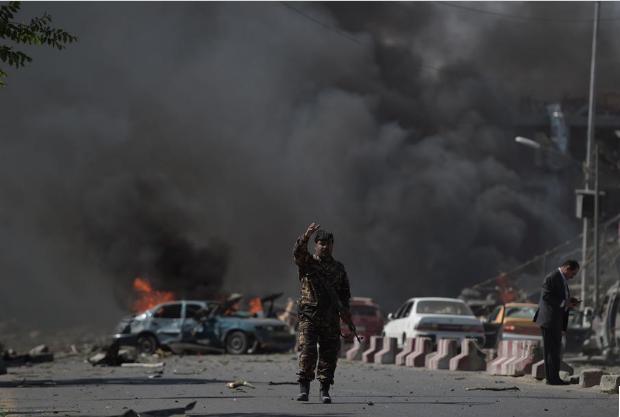Human Rights Watch – (New York, January 18, 2018) – Afghanistan’s armed conflict took a high toll on civilians throughout the year, with insurgents carrying out particularly deadly suicide attacks in urban areas, Human Rights Watch said today in its World Report 2018. A new national policy to mitigate harm to civilians during military operations may have contributed to a decrease in civilian casualties by Afghan government forces, but expanded US and government airstrikes caused increased civilian losses.
 An Afghan security force member stands at the site of a car bomb attack in Kabul on May 31, 2017. At least 90 people were killed or wounded on May 31 as a massive blast ripped through Kabul’s diplomatic quarter, shattering the morning rush hour and bringing carnage to the streets of the Afghan capital. © 2017 Shah Marai/AFP/Getty Images
An Afghan security force member stands at the site of a car bomb attack in Kabul on May 31, 2017. At least 90 people were killed or wounded on May 31 as a massive blast ripped through Kabul’s diplomatic quarter, shattering the morning rush hour and bringing carnage to the streets of the Afghan capital. © 2017 Shah Marai/AFP/Getty Images
In the 643-page World Report, its 28th edition, Human Rights Watch reviews human rights practices in more than 90 countries. In his introductory essay, Executive Director Kenneth Roth writes that political leaders willing to stand up for human rights principles showed that it is possible to limit authoritarian populist agendas. When combined with mobilized publics and effective multilateral actors, these leaders demonstrated that the rise of anti-rights governments is not inevitable.
In Afghanistan, the government’s human rights policy reforms failed to translate into meaningful improvements in curbing torture. Government pledges to end the use of unscientific and abusive “virginity examinations” for women taken into custody, and the imprisonment of women for so-called morality crimes, did not materialize.
“While the Afghan government made progress in passing crucial legislation on torture and recognizing state practices that harm women, real change is not yet realized,” said Patricia Gossman, senior South Asia researcher at Human Rights Watch. “It’s not enough to enact reforms – there needs to be a meaningful commitment to enforce them.”
Afghanistan’s civil war continued in 2017, with the United Nations Assistance Mission to Afghanistan (UNAMA) documenting 2,640 war-related civilian deaths and 5,379 injuries in the first nine months of 2017, a slight decrease over the same period in 2016. The Taliban and armed groups claiming allegiance to the Islamic State of Khorason Province (ISKP), the Afghan branch of the extremist armed group Islamic State (also known as ISIS), were responsible for two-thirds of these. Deaths and injuries from aerial operations by government and international forces increased by 52 percent to 205 deaths and 261 injured. The year looked likely to be the bloodiest since 2001 for Afghan journalists – with 11 killed, most of them the victims of insurgent bombing attacks.
The number of internally displaced persons due to the conflict surged as fighting intensified mid-year. More than 250,000 were displaced in the first 10 months of 2017, bringing the nationwide total to at least 1.7 million people. They included hundreds of thousands of refugees that Pakistani authorities pressured to leave Pakistan in 2016.
In March, the government enacted anti-torture legislation, delayed since 2015. The law omitted a system for compensation for victims of torture by state security forces, but in August the cabinet approved an annex to provide for victim redress. A UNAMA report covering the period from January 2015 through December 2016 documented the highest levels of torture of conflict-related detainees in police custody since 2010. No high-level officials were prosecuted for torture.
In September, diplomatic sources indicated that the US was supporting an Afghan government initiative to create an additional local defense force, the Afghan National Army Territorial Force. The force would reportedly absorb some existing militias under army command, though it remained unclear how it would avoid replicating the record of the abusive Afghan Local Police. The US military command in Afghanistan also began classifying key data related to the development of Afghan security forces, most of which has been public since 2008.
“Trying to bring stability to Afghanistan through irregular militia forces is irresponsible and dangerous,” Gossman said. “All armed forces in Afghanistan need to adhere to the laws of armed conflict, be held responsible when they don’t, and recognize that reducing harm to civilians is essential for genuine security.”

